Osteochondria is a widespread disease of intervertebral discs, which occur in people of different age groups.Today it is diagnosed in more than 40% of young people under 35 years of age, and among the older class affects 9 of 10 people.It has several stages of growth, and the earlier the pathology is detected, the easier and more effective the treatment is and the lower the risk of developing dangerous complications.
What is osteochondria
The intervertebral discs are located between the vertebral bodies and are a kind of shock absorbers that absorb stress when walking or performing other physical activities.They have different sizes depending on their location: in the cervix area the discs are the smallest and in the lumbar spine are the largest.
They are all built the same.At the center there is the Pulposus core, which is the main ingredient of the disk and has high elasticity.It is surrounded by fibrous membrane and final plates.
Osteochondria is a degenerative dystrophic disease in which there is a change in the shape and size of the intervertebral discs as a result of their friction and the conditions for the formation of herbs, the deformation of the vertebral bodies, the vertebrae and other disorders are created.
Dilution of discs is a consequence of the malnutrition of cartilage tissue, which leads to a gradual reduction of its elasticity and increased fragility.
As a result, the discs change their position, their height decreases and the microconsty are formed in their fibrous membrane.This creates serious conditions for the formation of intervertebral gardens, spine roots or blood vessels.
The slightest changes in the state of the discs lead to the interruption of their functions.This is accompanied by pain in varying degrees of tension.At the same time, conditions are created for the development of internal organs, as the quality of their activity depends directly on the condition of the spine and the conductivity of bioelectric impulses along the nerves.
May affect one or more intervertebral discs in any part of the spine.Therefore, osteochondria is diagnosed:
- Cervical spine.
- thoracic spine.
- Lumbar spine.
In particularly serious cases, the pathological process involves the majority of the intervertebral discs of the spine, which is accompanied by discomfort throughout the back and almost complete loss of efficiency.But more often, osteochondria affects the lumbar spine, as it carries the highest load, as well as the intervertebral discs of the cervical spine due to their high mobility.
Development
During osteochondry, 4 stages can be distinguished about:
- Reduce the level of hydration of the disk, which leads to its dehydration and micro -formation.Often at this stage there are no manifestations of the initial disease yet.
- Reduction in the height of the disc, leading to the appearance of the first symptoms of pathology.At this stage, there is a decrease in the distance between individual sections, which leads to a reduction in spinal tone and creates the ability to displace the vertebrae from their natural positions, ie in such situations more often observes a course that resembles a wave of disease.It can distinguish between periods of frenzy, accompanied by acute pain and periods of recession, in which there is no discomfort or pain.
- Deformation of the affected intervertebral disc with the formation of protrusion or progress.Sometimes there is involvement of the joints in the pathological process, which is manifested by the development of arthritis or vertebral hypoglycaemia.At this stage, the immune system reacts to the processes that occur in the spine by developing aseptic inflammation by swelling of the tissues surrounding the affected part of the spine.In this case, the pain occurs regularly, reflexive muscle spasms can be observed, as well as restrictions on mobility.In rare cases, the signs of the neurological deficit (radical syndrome) are already developing as a result of the nerve fiber sting from the resulting protrusions of the intervertebral discs.
- Developing complications.Since the human body has broad compensatory potential, when the intervertebral disc loses its ability to perform its functions, the osteoseptic process is activated to ensure the vertebrae in a stable position.This leads to the formation of bone protrusions - osteophytes - at the edges of the vertebral bodies of the affected part of the vertebral movement.As a result, because of them, two or more vertebrae are firmly merged together, forming a single complex, that is, spondy is developed.This always leads to nerve sting and to the development of acute neurological symptoms in the form of swap, paralysis and severe disorders in the functioning of the corresponding internal organs.
Reasons
Today there are many theories about the development of osteochondicism, including vascular, mechanical, hereditary, hormonal, infectious allergic and others.But none of them are able to fully explain the mechanism of developing changes in the tissues of intervertebral discs.Therefore, most likely, everyone complements each other.
Thus, a huge number of very different factors can lead to the development of osteochondry.Among them, the most important are:
- Genetic predisposition.
- regular performance of heavy physical work;
- maintaining a sedentary lifestyle.
- the presence of scoliosis or other spine deformations.
- suffer from injuries to the back.
- Unbalanced diet, vitamin deficiency.
- Infectious diseases.
- Metabolic disorders.
- Congenital spine abnormalities (Kimerli abnormality, chiari abnormality, cranovanne cell abnormalities, sacredness, lumbar substance).
- overweight;
- Regular severe pressure.
It is believed that the most significant effect on the state of the intervertebral discs is the constant overload of a particular part of the spine.This can not only perform monotonous hard physical work, but also a steady turn or habit of sitting for a long time.In such situations, additional stress is placed on the discs, muscles and joints and other factors only aggravate the condition.
In general, osteochondria can be called an almost age -related natural disease, which is an inevitable price to pay for walking upright.
Symptoms
The earliest sign of disease development is the appearance of a crisp sound in the part of the spine where the appearance of degenerative double changes is observed.It is a consequence of the occurrence of disk nutrition and the evolution of its dehydration.At this stage, patients almost never seek medical attention.Therefore, their daily routine, eating habits and other factors remain the same, which contributes to the deterioration of the situation and to the transition of the disease to the second stage.
As a result, the symptoms that are characteristics of osteochondalism begin to appear:
- Severe muscle intensity in the affected area only on one or both sides of the spine.
- sharp and cunning aches that exacerbate every movement and intensity of profit over time, making it unbearable.
- numbness in the hands or feet.
- weakness;
- stiffness of movements, unauthorized restriction of mobility.
- reduced muscle tone to complete atrophy.
- Misstatement
- Increases blood pressure.
As the pathology evolves, the signs of osteochondicism worsen.80% of patients have boring pain in the area of the affected part of the spine, which is also characteristic of myositis.
Cervical spine osteochondria
When the cervical spine is affected, the pain tends to radiate in the shoulder belt, hands and other manifestations of neurological disorders.Patients keep their heads in the less painful position and, if necessary, turn their whole body.
In addition, organ pathologies that are encouraging from the spinal cord of the cervical spine may be developed:
- tinnitus and diseases of ENT organs.
- dizziness;
- Blurred vision?
- migraines;
- Irritability and stress levels are increasing.
- sleep problems;
- increased risk of allergic reactions;
- Reduced levels of thyroid hormones.
With cervical spine osteochondria, spine syndrome and vegetable-vascular dystonia are often more diagnosed.
Infection of the cervical spine with osteochondria, especially when complicated by protrusions and intervertebral hernias, can lead to a sting of blood vessels.This is full of weakened blood supply to the brain, which may be accompanied by dizziness attacks, loss of consciousness and even a stroke.
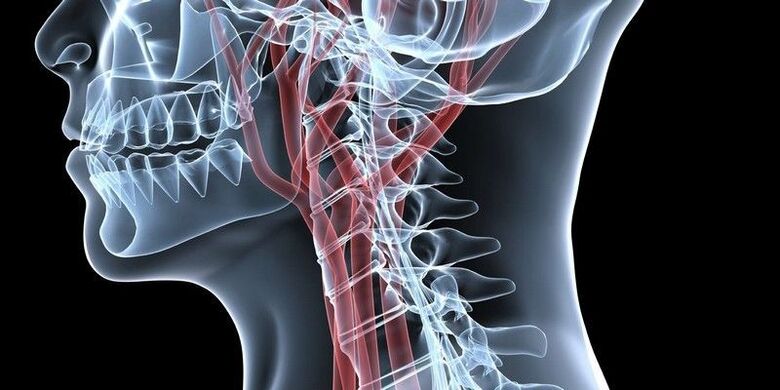
Osteochondria of thoracic spine
With the osteochondria of the thoracic area, which is rarely diagnosed, the pain occurs in the spine at the shoulder level and can exacerbate even when it takes deep breathing.They are often felt behind the chest, which can be wrong for heart disease.
When spine roots are stinging, the risk of internal organs diseases increases, in particular:
- Bronchi and lungs (asthma, bronchitis, pneumonia, side).
- The gall bladder and its conductor, the liver (cholecystitis, jaundice, fat absorption disorders).
- Pancreas and duodenum (digestive disorders, pain in the left hypochondria).
- Adrenals, which affect the overall power of the immune system and can cause allergies to grow.
- Kidney (urinary disorders, chronic pyelonephritis, glomerulonephritis, etc.).
- Pelvic organs (digestive disorders, gynecological, urological diseases, infertility).
Event: Damage to the intervertebral disc of the 7th thoracic vertebra from osteochondria can lead to the development of diabetes mellitus.
Lumbar spine osteochondria
With the osteochondria of the lumbar region, Lumbago, called Lumbago, is observed.This is accompanied by burning, unbearable pain that suddenly occurs.Often, patients find it difficult to sit, rise and walk, which may indicate the development of a radical syndrome.In such situations, it is easy to observe how they sit slowly and get up, trying as much as possible to avoid tilting their torso.
If complications occur, the main risk is Cauda Equina's nerve sting, as this can lead to reduced control of bowel -bladder evacuation processes, as well as feet paralysis.Also in such cases it may be developed:
- appendicitis;
- diarrhea, constipation.
- pain in the lower abdomen.
- bladder malfunction.
- inability;
- Pain on knees, legs, hips or groin area.
- swelling of the legs.
Complications
Osteochondria is a possible cause of a huge number of different diseases.Most of the time, if left untreated, it leads to the formation of protrusion and intervertebral hernia.This in turn can cause:
- Billbish myelopathy, which results in the stubbornness, muscle atrophy, the changes in tendon reflexes, the loss of urination control and abstraction, and even the paralysis of the limbs.
- Rizopathy?
- scoliotic or other vertebral deformation;
- spinal cord infarction due to the compression of the artery that feeds it.
- stroke due to compression of the occipital artery.
Diagnosis
The appearance of back and neck pain must be a reason to contact a neurologist or vertebral.The faster the osteochondria is diagnosed, the easier and more effective the treatment will be.
To diagnose the disease, the doctor interviews and examines the patient.Based on their results, it is already possible to assume the presence of degenerative changes in the intervertebral discs.But for a final diagnosis, organic diagnostic methods are prescribed, including:
- MRI?
- Ct?
- X -ray in two views.
Magnetic resonance imaging provides the most comprehensive information on the state of the intervertebral discs.The procedure is mainly carried out on closed -type devices with a power of 1.5 s. With its help, you can differentiate osteochondria from tuberculosis spondylitis, osteomyelitis, infectious diseases, etc.
CT scans and X -rays provide information on the bone structures of the spine.Thanks to them, it is possible to detect the displacement of the vertebral bodies, the presence of osteophytes and other disorders.
In addition, the following can be prescribed:
- Ultrasound with doping of the throat containers.
- Electromyography?
- Laboratory research.
Treatment of osteochondry
Treatment develops individually for each patient.In this case, the severity of degenerative duplicate processes, the presence of complications, the nature of the patient's work activity and a number of other factors must be taken into account.
All patients should be prescribed a set of measures, as it is impossible to eliminate pathological changes in intervertebral discs only with the help of drugs.The ingredients of conservative treatment for osteochondria may include:
- pharmaceutical treatment;
- osteopathy;
- manual treatment?
- Physiotherapy (phonophobilization, ozone therapy, carboxystherapy, pressure, RF currents).
- individual sessions with restoration.
All patients diagnosed with the dystrophy of the intervertebral discs are advised to review their lifestyle.It is imperative that the time for moderate physical activity be set aside, especially for representatives of sedentary occupations or, conversely, to think of the ability to change professions for people who are forced to lift heavy objects every day.
But in the acute period, complete rest is recommended.It is ensured not only by maintaining the bed rest, but also with the wear of the orthopedic bandages: in the event of damage to the cervical spine, a Shants collar is used.In the case of osteochondicity of the lumbar region, it is recommended to wear a corset.
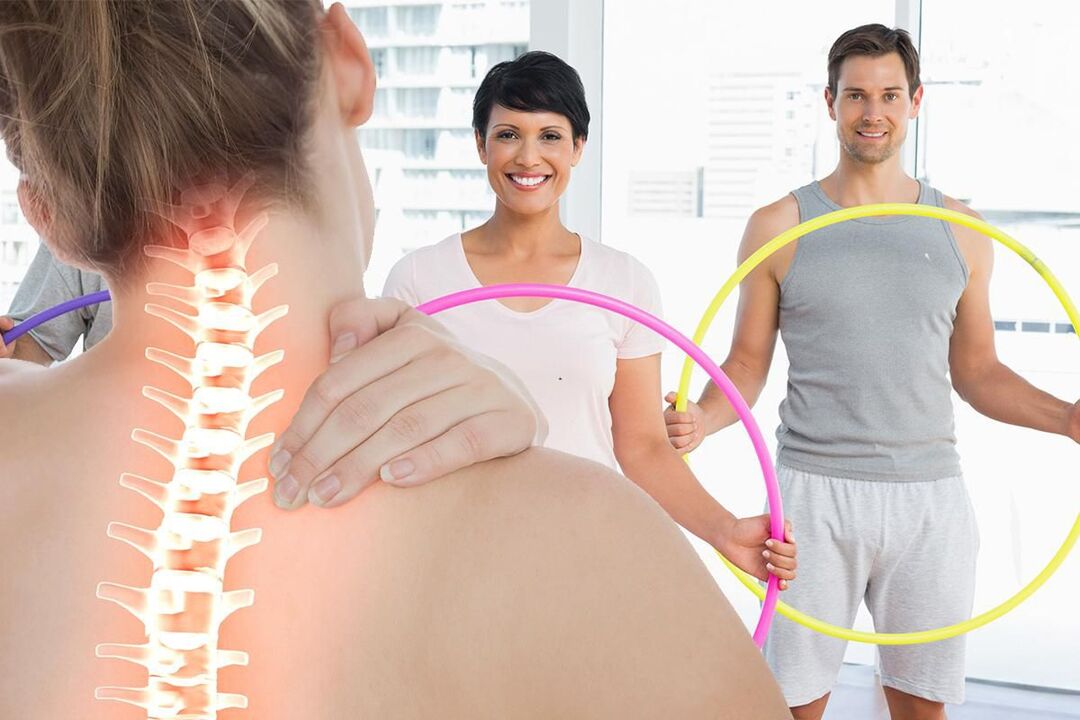
In the early stages of disease development, it is often enough to make adjustments to your lifestyle, participate in exercise therapy and visit a chiropractor.In more advanced cases, pharmaceutical therapy and physiotherapy are necessarily prescribed.
Never resort to self-healing by doubtful means, self-protection of anti-inflammatory drugs, as well as dubious "therapists" placed on the Internet: you can lose not only time, money, but also ruins of your health.
Pharmaceutical treatment
For osteochondria, a drug complex is prescribed to reduce pain, eliminate inflammation and reflexive muscle spasms, improve nerve conductivity and activating the regeneration of intervertebral discs.
Therefore, patients are prescribed:
- NSAIDS-Emphate to reduce pain and have anti-inflammatory effect.
- Corticosteroids-present strong anti-inflammatory properties.
- Muscle relaxants - eliminate muscle spasms, which help reduce back pain.
- B Vitamins - Provide improved function of the nervous system in general and the conductivity of nerve impulses along individual nerves in particular.
- Vitamin D is a treatment responsible for bone tissue condition, as well as for higher brain functions, such as memory, attention, speech.
- DANCE - Draw the intervertebral discs with the compounds necessary for the construction of new core fibers.
- Psychotropic Medicines-Expand the effectiveness of non-steroidal anti-inflammatory drugs and muscle relaxation.
- Vascular drugs - Improve blood circulation to tissues surrounding the spine, which ensures a more active supply of nutrients and oxygen to intervertebral discs.
- Antimaluming - are used in rare cases to relieve very serious convulsions.
For very severe pain, which often indicates complications, patients can undergo rear blockages, which provide an immediate effect.Sometimes corticosteroid hormones are added to the solution to perform the blockade.This also leads to an intense anti -inflammatory effect.
Exclusions are performed under conditions of absolute infertility, which can only be achieved in specialized medical institutions.At the same time, they require special knowledge and skills, so only a highly qualified health worker can handle work well.Otherwise, there is a high risk of infection or damage to the nerve fibers, which will lead to the development of serious complications.
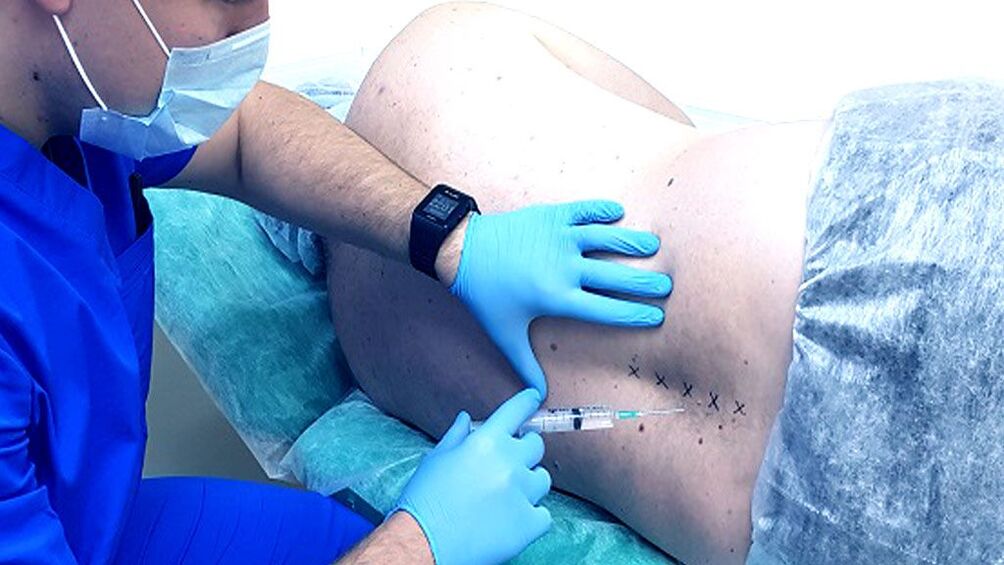
During the blockade, injections are usually given on both sides of the spine in the area where the pain -causing nerves appear.There are several techniques for their execution, including this particular chosen by the doctor individually.
But it is advisable to perform exclusions no more than 4 times a year.Since with osteochondria, the attacks of acute, painful pain occur much more often, it is worth first of all the efforts to eliminate the causes of their appearance, that is, the degenerative duplicate process in the joint itself.
Manual treatment
Manual therapy sessions are prescribed outside of the osteochondal deterioration period.They play one of the leading roles in the treatment of disease, as the competent use of manual techniques in the spine and surrounding tissues not only stop the pathological process in the intervertebral discs, but also to create the most favorable conditions for their restoration.
In addition, some techniques can also have a positive effect on the functioning of the internal organs.For example, one of the methods is designed, by normalizing the position of each vertebrae, to eliminate pressure on spine roots, blood vessels and vertebral membranes and thus restore the normal connection of the organ to the nervous system.This makes it possible to eliminate the hidden causes of the development of the above heart disease, bronchi, lungs, kidneys, gastrointestinal tract and reproductive system and leads to complete recovery.
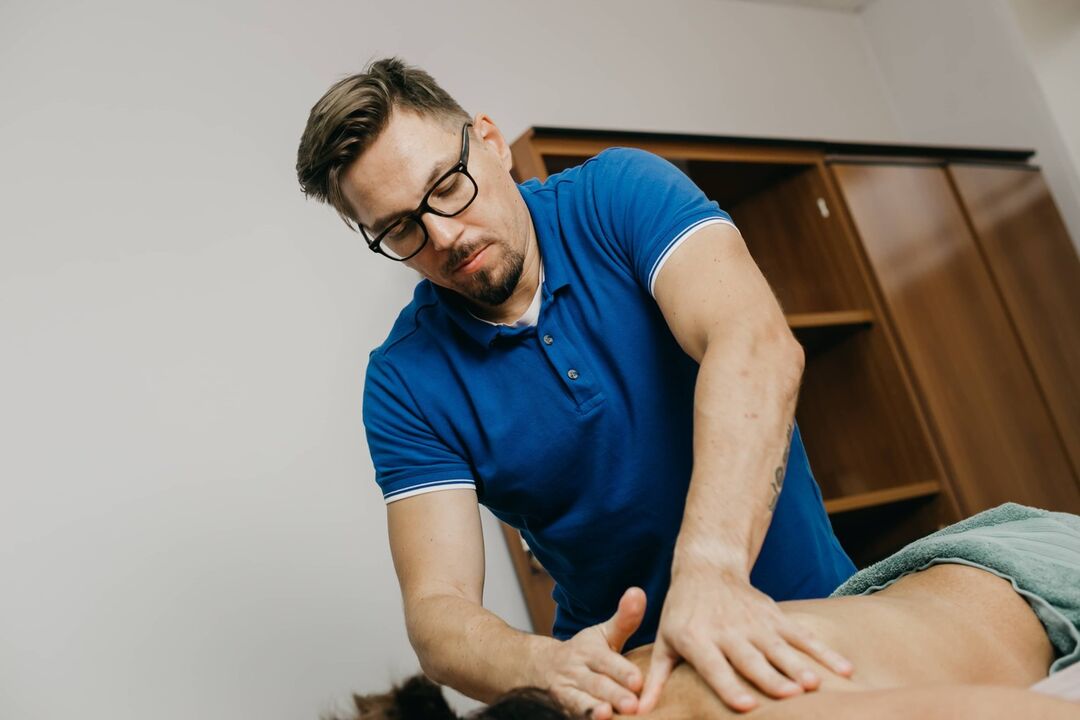
Thanks to the effect of spine accuracy, not only blood circulation is activated and metabolism is accelerated, as is the case with a classic therapeutic massage, but also natural self -treatment mechanisms begin.The elimination of spine curves, the incorrect position of the vertebrae and other pathological changes in the spine through manual therapy can further enhance the immune system, improve overall well -being and significantly improve quality life.
Positive changes can be observed after the first session and in the future their severity only increases.
Physiotherapy
Physiotherapeutic processes increase the effectiveness of all other methods of treatment of osteochondry and help reduce pain.Used most often:
- Electrophoresis - the use of electricity to ensure the penetration of anesthetic, anti -inflammatory and other factors directly into the place of inflammation, allowing you to quickly obtain a strong therapeutic effect.
- Ultrasound Therapy - The effect of ultrasound provides an analgesic effect, enhances the intensity of metabolic processes in the field of influence and creates the conditions for high quality restoration of diluted intervertebral discs.
- Detector therapy - includes stretching and spine massage in a special layer of rod, which activates blood circulation and increases muscle tone.
- The adhesion therapy or spine attraction - is performed using special devices that create a tensile load on the spine, as a result of which the distance between the vertebrae and the pressure on the worn intervertebral disc is increased, is strongly reduced, which allows it to recover.
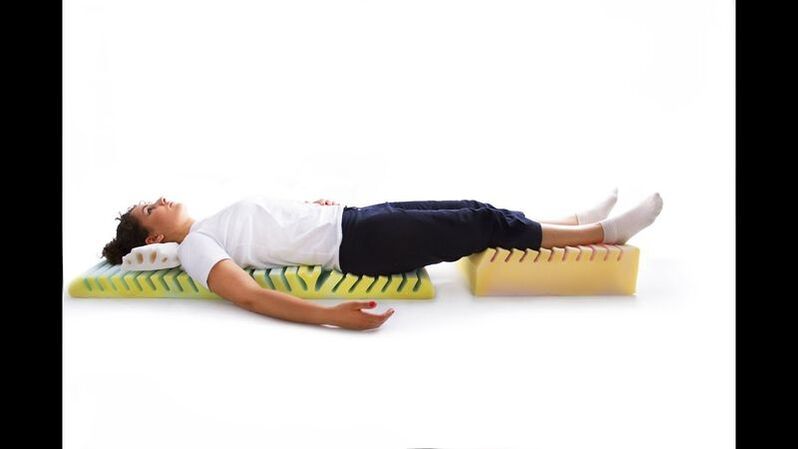
All procedures are prescribed in 10-15 sessions.When choosing, they take into account not only the condition of the intervertebral discs, but also the presence of consequent diseases, as some of them some physical effects are contraindicated.
Exercise treatment
Therapeutic exercises for osteochondria play an important role, since properly selected exercises for damage to various parts of the spine can help create a strong muscle corset and at the same time eliminate increased muscle tone.This will provide good spine support and stop the development of the degenerative process in the intervertebral discs.In addition, exercise therapy helps to activate blood circulation and increase the intensity of metabolic processes.
The preparation of a physiotherapy program is the task of a rehabilitation doctor.Based on the severity of the spine, the characteristics of the patient's natural development, age and other factors will create an optimal set of exercises, the application of which will create an optimal load on the muscles and spine.
The first classes must be carried out under the supervision of a doctor.Once the patient learns to perform any exercise correctly, he is allowed to continue to practice at home.It is important to avoid any sudden movements.All exercises are performed daily slowly and smoothly and the load is gradually increasing.But the appearance of pain during exercise is a good reason to refuse to perform the exercise that caused it.

Prevention
It is much easier to avoid developing a disease than to address its consequences later.Since osteochondria can happen to everyone sooner or later, you should think of the potential risks as early as possible and make every effort to avoid this.Therefore, each person must adhere to the following recommendations:
- Avoid natural inactivity, regular exercise, swimming and during the living, take regular breaks to warm up.
- Pay attention to your attitude when walking or sitting.
- Buy an orthopedic mattress of high quality and pillow.
- Notice the correct technique for lifting the weights: with straight back and bent knees.
- Change the occasional shoes to the most comfortable and leave the shoes for special occasions.
- Eat to the right so that the body does not have dietary deficiencies and the weight remains within the normal limits.
There is only one way to avoid the appearance and manifestation of the symptoms of osteochondry - start taking care of yourself and your health.Since osteochondria is not only a disease, but a cluster of muscle-tones and neurocycopic changes, which constitute the body's response to natural inactivity, chronic static intensity of the vertebral muscles, environmental condition and chronic nerve, especially inhabitants.
Thus, osteochondria is a very common disease, but with special attention to your own health, you can effectively fight it at any age.But the breach of the problem will not lead to anything good and sooner or later will force the patient to be on the table.


























